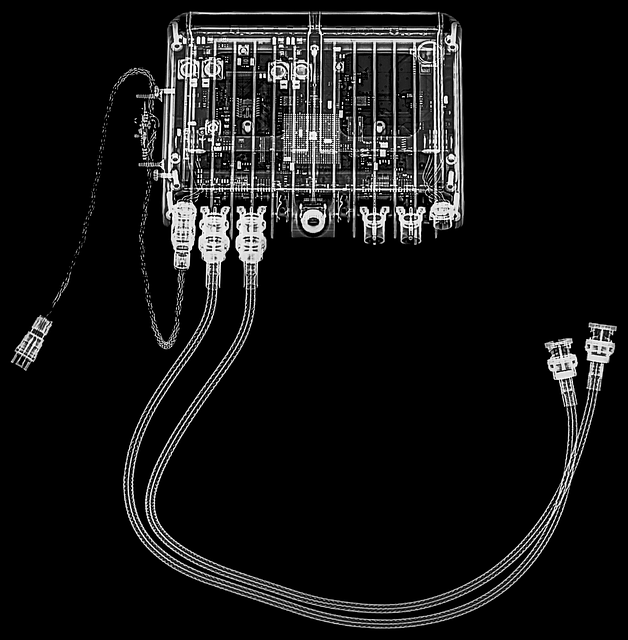Iodinated contrast agents (ICAs) are crucial tools in medical imaging, enhancing soft tissue visibility on X-rays. These compounds interact with X-rays to create distinctive patterns, highlighting internal structures like muscles, organs, and vasculature. Administered intravenously, ICAs accumulate in specific organs, providing high-contrast images vital for detecting anomalies. With varying molecular weights and clearance rates, different ICAs offer tailored advantages from minimal radiation exposure to prolonged contrast for dynamic studies. Radiologists select the most suitable ICA based on examination type, improving diagnostic accuracy and efficiency across various X-ray procedures, while ensuring patient safety with proper monitoring due to potential adverse effects.
“Iodinated contrast agents (ICAs) play a pivotal role in enhancing soft tissue visualization on X-ray imaging. This article delves into the intricate mechanisms behind ICA functionality, exploring how they improve the clarity of internal body structures that are often challenging to discern. We examine their applications in radiology, highlighting benefits such as better diagnosis and treatment planning. Additionally, safety considerations and future prospects in contrast agent use will be discussed, offering insights into advancements in this essential field.”
Iodinated Contrast Agents: An Introduction to Their Role in X-ray Imaging
Iodinated contrast agents (ICAs) play a pivotal role in enhancing soft tissue visualization during X-ray imaging. These specialized compounds, containing iodine atoms, interact with the X-ray beam to produce distinct patterns that highlight specific tissues within the body. When administered intravenously, ICAs settle in various organs and blood vessels, providing high-contrast images that would otherwise be challenging to acquire. This capability is particularly valuable for detecting anomalies in soft tissues like muscles, organs, and blood vessels, which often lack visible features under standard X-ray conditions.
ICAs are designed to differ in terms of molecular weight, ionization potential, and clearance rates, each offering unique advantages. Faster clearing agents ensure minimal radiation exposure over extended periods, while slower agents can provide longer-lasting contrast for dynamic studies. This versatility allows radiologists to tailor ICA selection based on the specific requirements of various X-ray examinations, such as angiograms, venograms, or abdominal imaging, thereby enhancing diagnostic accuracy and efficiency.
Enhancing Soft Tissue Visibility: The Mechanism Behind Contrast Agents
Soft tissue visualization in X-ray imaging is a complex challenge, as these tissues often appear similar in intensity to bone structures. However, the introduction of contrast agents has revolutionized this field, significantly enhancing the visibility and distinction of soft tissues. Iodinated contrast agents, for instance, play a pivotal role in improving diagnostic accuracy.
These agents, containing iodine atoms, interact with X-rays in a unique way, leading to marked differences in tissue attenuation. When administered intravenously, they accumulate in various soft tissues, such as muscles and organs, causing them to appear brighter or darker against the surrounding structures on X-ray images. This mechanism exploits the inherent properties of iodine to absorb and scatter X-rays, thereby creating a distinct contrast that aids radiologists in interpreting anatomical details with greater precision.
Applications and Benefits of Using Contrast Agents in Radiology
In radiology, the application of contrast agents plays a pivotal role in enhancing soft tissue visualization on X-ray images. Iodinated contrast agents, for instance, are frequently used to improve the distinction between various tissues and structures within the body. These agents, when injected into the bloodstream, are taken up by different types of cells at varying rates, leading to distinct radiological appearances. This property allows radiologists to better identify abnormalities or pathologies that might be obscured in regular X-ray examinations.
The benefits of using contrast agents are numerous. They facilitate a more accurate diagnosis by highlighting specific organs, blood vessels, and tissues. This is particularly crucial in the detection of tumors, bleeding, inflammation, and other soft tissue abnormalities. Additionally, iodinated contrast agents can help in assessing the functionality of organs, such as the kidneys and liver, by providing information on blood flow and perfusion. These applications collectively contribute to more effective patient care and improved clinical outcomes.
Safety Considerations and Future Prospects in Contrast Agent Use
While iodinated contrast agents have significantly enhanced soft tissue visualization in X-rays, their use isn’t without safety considerations. These agents, due to their high iodine content, can interact with various bodily systems if not handled properly. Accidental exposure or overdose may lead to adverse effects, especially in patients with pre-existing conditions like kidney disease. Healthcare providers must carefully monitor patient health and adhere to recommended dosages to ensure safety during procedures.
Looking ahead, ongoing research focuses on developing safer alternatives and improving existing iodinated contrast agents. This includes exploring novel agents with different chemical compositions that could offer enhanced benefits while minimizing risks. Additionally, advancements in X-ray technology itself may reduce the need for contrast agents in certain cases, paving the way for a future where imaging can provide detailed insights without associated health concerns.
In conclusion, iodinated contrast agents play a pivotal role in enhancing soft tissue visualization during X-ray imaging. By understanding their mechanism of action and exploring various applications, radiologists can optimize diagnostic accuracy. While safety considerations are paramount, ongoing research points to promising future prospects for these agents in advancing radiology practices.
